Occupational Management Plan for Uranium Mining
VerifiedAdded on 2023/01/10
|14
|2888
|43
AI Summary
This management plan reviews the Olympic Dam Uranium mining industry with a focus on the long-term occupational hazards, specifically lung cancer. It includes a clear description of the workplace demography, risk assessment, a critical review of relevant literature, a management plan, and emergency response measures.
Contribute Materials
Your contribution can guide someone’s learning journey. Share your
documents today.
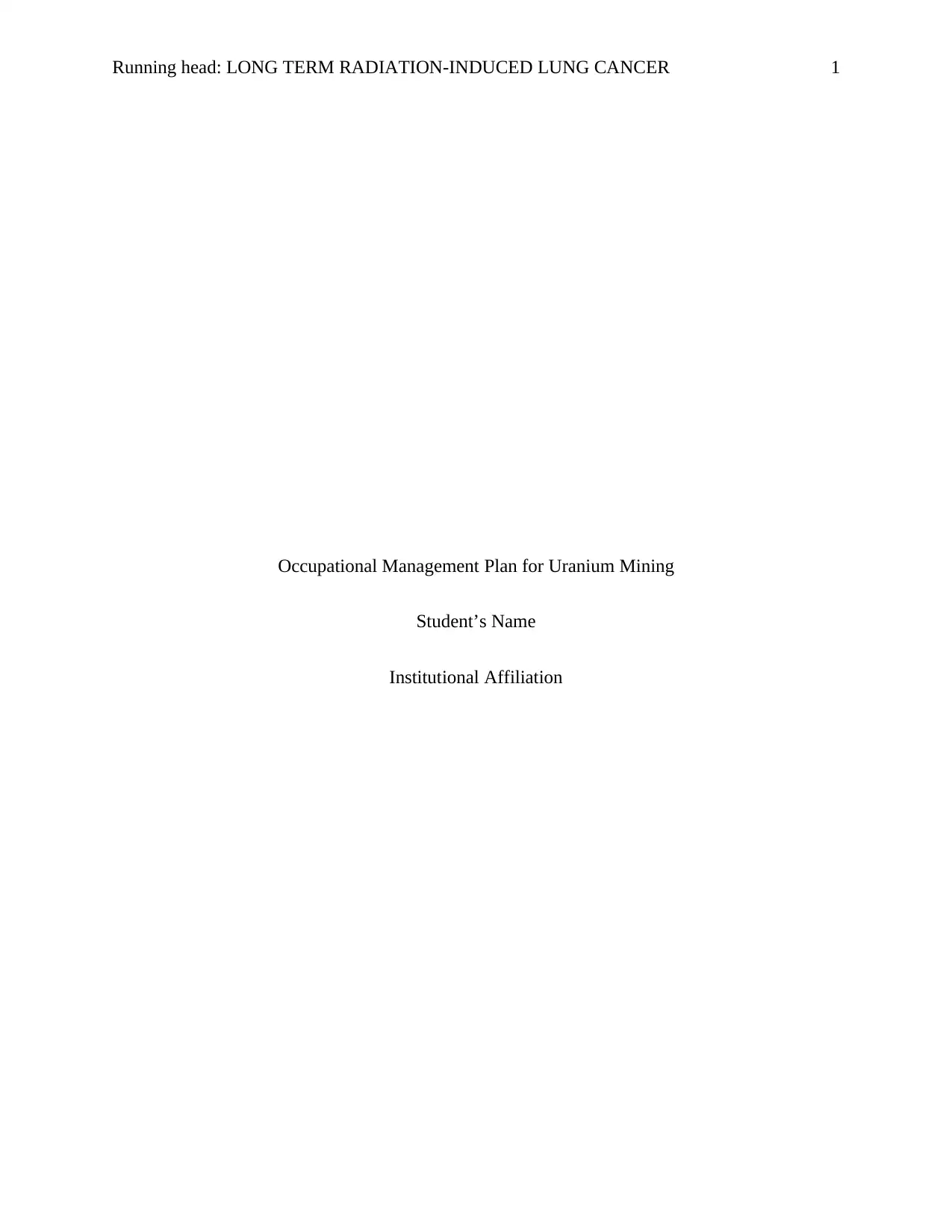
Running head: LONG TERM RADIATION-INDUCED LUNG CANCER 1
Occupational Management Plan for Uranium Mining
Student’s Name
Institutional Affiliation
Occupational Management Plan for Uranium Mining
Student’s Name
Institutional Affiliation
Secure Best Marks with AI Grader
Need help grading? Try our AI Grader for instant feedback on your assignments.
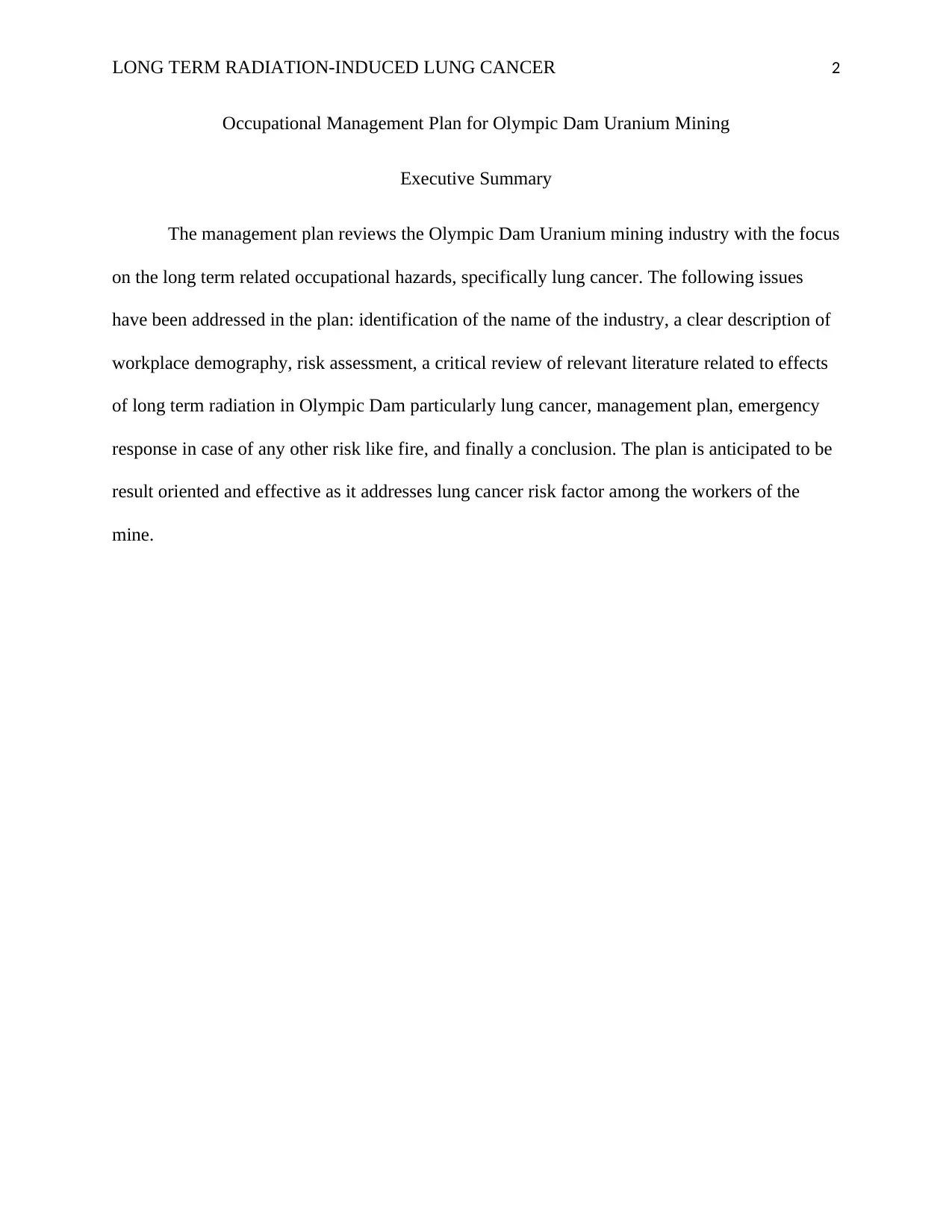
LONG TERM RADIATION-INDUCED LUNG CANCER 2
Occupational Management Plan for Olympic Dam Uranium Mining
Executive Summary
The management plan reviews the Olympic Dam Uranium mining industry with the focus
on the long term related occupational hazards, specifically lung cancer. The following issues
have been addressed in the plan: identification of the name of the industry, a clear description of
workplace demography, risk assessment, a critical review of relevant literature related to effects
of long term radiation in Olympic Dam particularly lung cancer, management plan, emergency
response in case of any other risk like fire, and finally a conclusion. The plan is anticipated to be
result oriented and effective as it addresses lung cancer risk factor among the workers of the
mine.
Occupational Management Plan for Olympic Dam Uranium Mining
Executive Summary
The management plan reviews the Olympic Dam Uranium mining industry with the focus
on the long term related occupational hazards, specifically lung cancer. The following issues
have been addressed in the plan: identification of the name of the industry, a clear description of
workplace demography, risk assessment, a critical review of relevant literature related to effects
of long term radiation in Olympic Dam particularly lung cancer, management plan, emergency
response in case of any other risk like fire, and finally a conclusion. The plan is anticipated to be
result oriented and effective as it addresses lung cancer risk factor among the workers of the
mine.

LONG TERM RADIATION-INDUCED LUNG CANCER 3
Contents
Executive Summary.........................................................................................................................2
Industry Name.................................................................................................................................4
Introduction......................................................................................................................................4
The Aims and Objectives.................................................................................................................4
Definitions.......................................................................................................................................5
Work Place Demography.................................................................................................................6
Assessment of Risk..........................................................................................................................6
Critical Review of Relevant Literature............................................................................................8
Management Plan............................................................................................................................9
Emergency Response.....................................................................................................................10
Evaluation......................................................................................................................................11
Conclusion.....................................................................................................................................12
References......................................................................................................................................13
Contents
Executive Summary.........................................................................................................................2
Industry Name.................................................................................................................................4
Introduction......................................................................................................................................4
The Aims and Objectives.................................................................................................................4
Definitions.......................................................................................................................................5
Work Place Demography.................................................................................................................6
Assessment of Risk..........................................................................................................................6
Critical Review of Relevant Literature............................................................................................8
Management Plan............................................................................................................................9
Emergency Response.....................................................................................................................10
Evaluation......................................................................................................................................11
Conclusion.....................................................................................................................................12
References......................................................................................................................................13
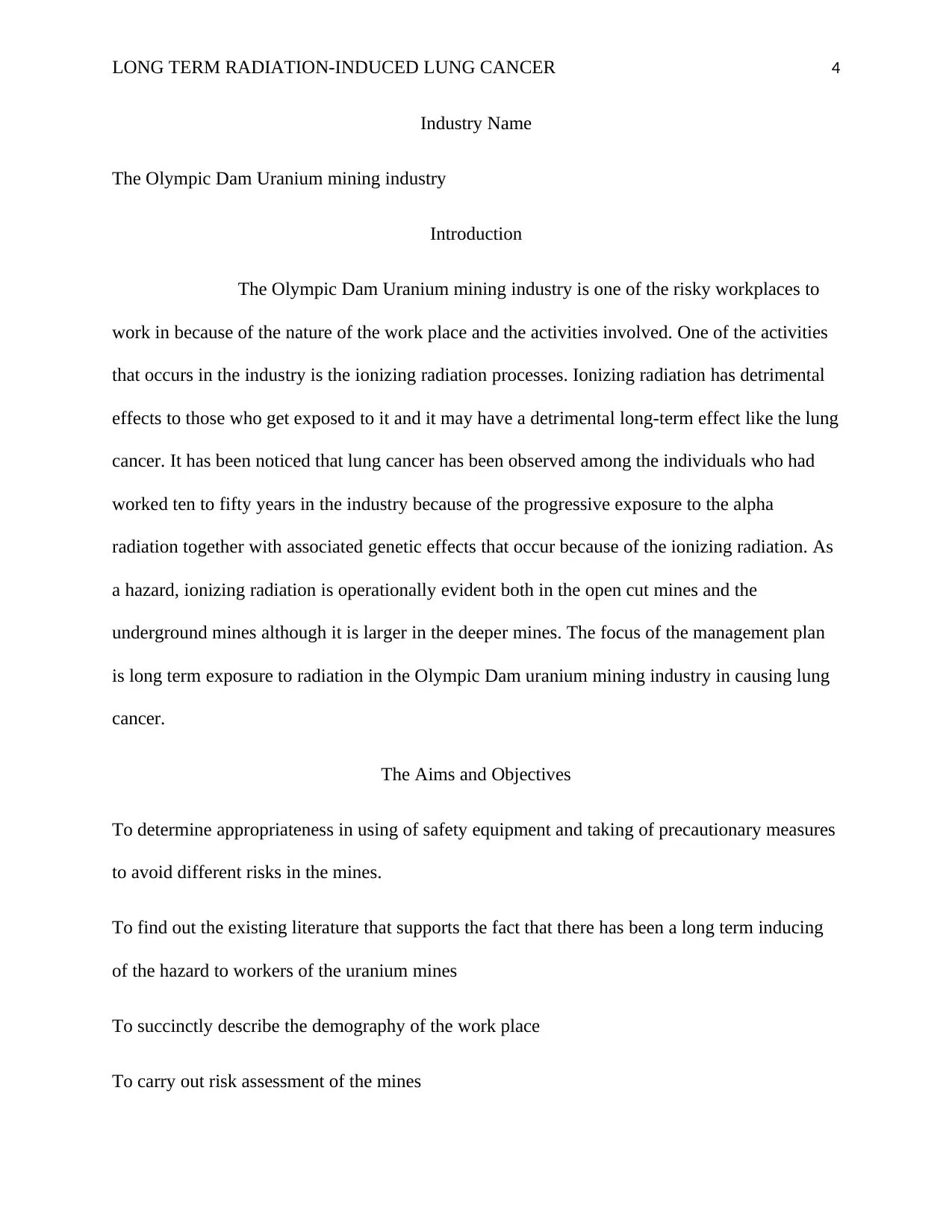
LONG TERM RADIATION-INDUCED LUNG CANCER 4
Industry Name
The Olympic Dam Uranium mining industry
Introduction
The Olympic Dam Uranium mining industry is one of the risky workplaces to
work in because of the nature of the work place and the activities involved. One of the activities
that occurs in the industry is the ionizing radiation processes. Ionizing radiation has detrimental
effects to those who get exposed to it and it may have a detrimental long-term effect like the lung
cancer. It has been noticed that lung cancer has been observed among the individuals who had
worked ten to fifty years in the industry because of the progressive exposure to the alpha
radiation together with associated genetic effects that occur because of the ionizing radiation. As
a hazard, ionizing radiation is operationally evident both in the open cut mines and the
underground mines although it is larger in the deeper mines. The focus of the management plan
is long term exposure to radiation in the Olympic Dam uranium mining industry in causing lung
cancer.
The Aims and Objectives
To determine appropriateness in using of safety equipment and taking of precautionary measures
to avoid different risks in the mines.
To find out the existing literature that supports the fact that there has been a long term inducing
of the hazard to workers of the uranium mines
To succinctly describe the demography of the work place
To carry out risk assessment of the mines
Industry Name
The Olympic Dam Uranium mining industry
Introduction
The Olympic Dam Uranium mining industry is one of the risky workplaces to
work in because of the nature of the work place and the activities involved. One of the activities
that occurs in the industry is the ionizing radiation processes. Ionizing radiation has detrimental
effects to those who get exposed to it and it may have a detrimental long-term effect like the lung
cancer. It has been noticed that lung cancer has been observed among the individuals who had
worked ten to fifty years in the industry because of the progressive exposure to the alpha
radiation together with associated genetic effects that occur because of the ionizing radiation. As
a hazard, ionizing radiation is operationally evident both in the open cut mines and the
underground mines although it is larger in the deeper mines. The focus of the management plan
is long term exposure to radiation in the Olympic Dam uranium mining industry in causing lung
cancer.
The Aims and Objectives
To determine appropriateness in using of safety equipment and taking of precautionary measures
to avoid different risks in the mines.
To find out the existing literature that supports the fact that there has been a long term inducing
of the hazard to workers of the uranium mines
To succinctly describe the demography of the work place
To carry out risk assessment of the mines
Secure Best Marks with AI Grader
Need help grading? Try our AI Grader for instant feedback on your assignments.
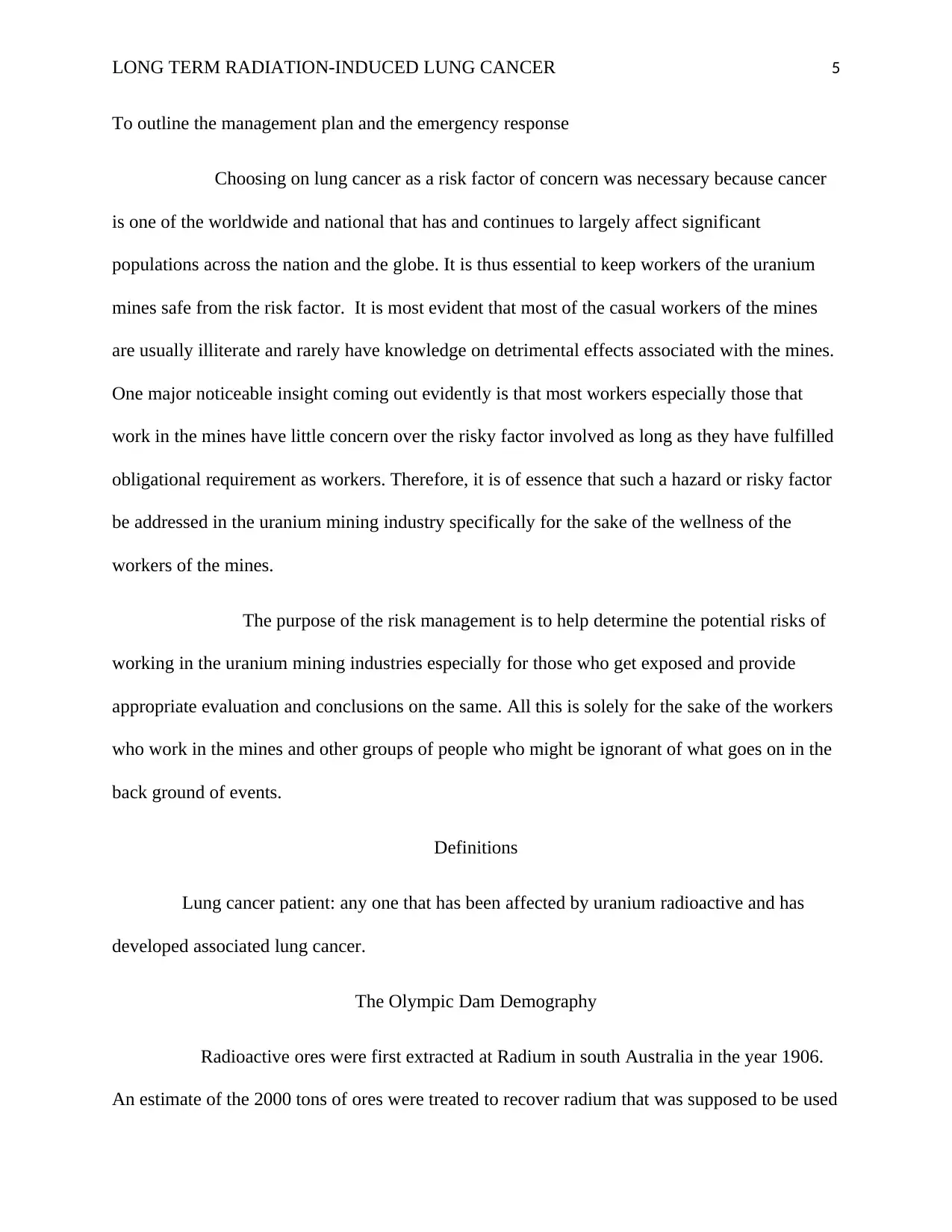
LONG TERM RADIATION-INDUCED LUNG CANCER 5
To outline the management plan and the emergency response
Choosing on lung cancer as a risk factor of concern was necessary because cancer
is one of the worldwide and national that has and continues to largely affect significant
populations across the nation and the globe. It is thus essential to keep workers of the uranium
mines safe from the risk factor. It is most evident that most of the casual workers of the mines
are usually illiterate and rarely have knowledge on detrimental effects associated with the mines.
One major noticeable insight coming out evidently is that most workers especially those that
work in the mines have little concern over the risky factor involved as long as they have fulfilled
obligational requirement as workers. Therefore, it is of essence that such a hazard or risky factor
be addressed in the uranium mining industry specifically for the sake of the wellness of the
workers of the mines.
The purpose of the risk management is to help determine the potential risks of
working in the uranium mining industries especially for those who get exposed and provide
appropriate evaluation and conclusions on the same. All this is solely for the sake of the workers
who work in the mines and other groups of people who might be ignorant of what goes on in the
back ground of events.
Definitions
Lung cancer patient: any one that has been affected by uranium radioactive and has
developed associated lung cancer.
The Olympic Dam Demography
Radioactive ores were first extracted at Radium in south Australia in the year 1906.
An estimate of the 2000 tons of ores were treated to recover radium that was supposed to be used
To outline the management plan and the emergency response
Choosing on lung cancer as a risk factor of concern was necessary because cancer
is one of the worldwide and national that has and continues to largely affect significant
populations across the nation and the globe. It is thus essential to keep workers of the uranium
mines safe from the risk factor. It is most evident that most of the casual workers of the mines
are usually illiterate and rarely have knowledge on detrimental effects associated with the mines.
One major noticeable insight coming out evidently is that most workers especially those that
work in the mines have little concern over the risky factor involved as long as they have fulfilled
obligational requirement as workers. Therefore, it is of essence that such a hazard or risky factor
be addressed in the uranium mining industry specifically for the sake of the wellness of the
workers of the mines.
The purpose of the risk management is to help determine the potential risks of
working in the uranium mining industries especially for those who get exposed and provide
appropriate evaluation and conclusions on the same. All this is solely for the sake of the workers
who work in the mines and other groups of people who might be ignorant of what goes on in the
back ground of events.
Definitions
Lung cancer patient: any one that has been affected by uranium radioactive and has
developed associated lung cancer.
The Olympic Dam Demography
Radioactive ores were first extracted at Radium in south Australia in the year 1906.
An estimate of the 2000 tons of ores were treated to recover radium that was supposed to be used
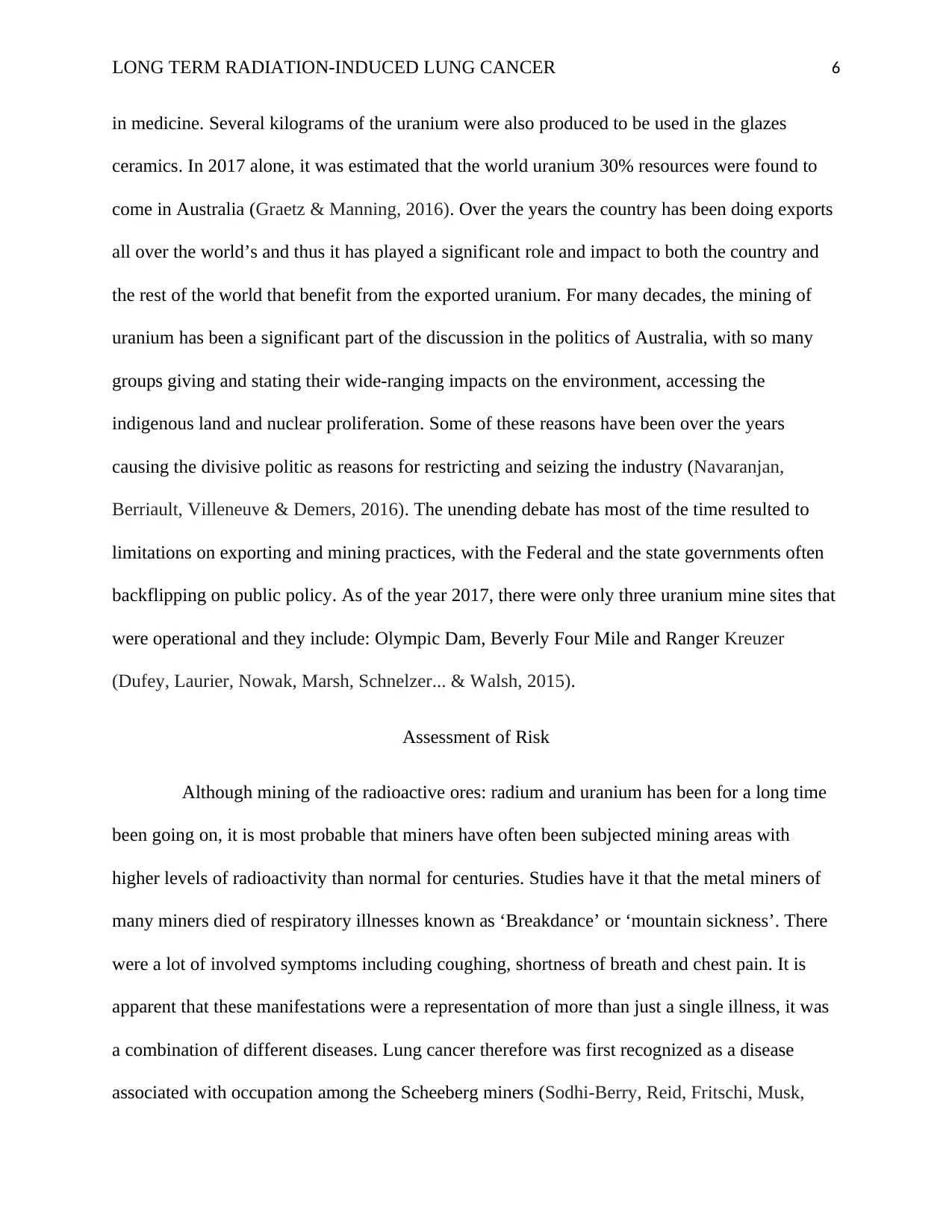
LONG TERM RADIATION-INDUCED LUNG CANCER 6
in medicine. Several kilograms of the uranium were also produced to be used in the glazes
ceramics. In 2017 alone, it was estimated that the world uranium 30% resources were found to
come in Australia (Graetz & Manning, 2016). Over the years the country has been doing exports
all over the world’s and thus it has played a significant role and impact to both the country and
the rest of the world that benefit from the exported uranium. For many decades, the mining of
uranium has been a significant part of the discussion in the politics of Australia, with so many
groups giving and stating their wide-ranging impacts on the environment, accessing the
indigenous land and nuclear proliferation. Some of these reasons have been over the years
causing the divisive politic as reasons for restricting and seizing the industry (Navaranjan,
Berriault, Villeneuve & Demers, 2016). The unending debate has most of the time resulted to
limitations on exporting and mining practices, with the Federal and the state governments often
backflipping on public policy. As of the year 2017, there were only three uranium mine sites that
were operational and they include: Olympic Dam, Beverly Four Mile and Ranger Kreuzer
(Dufey, Laurier, Nowak, Marsh, Schnelzer... & Walsh, 2015).
Assessment of Risk
Although mining of the radioactive ores: radium and uranium has been for a long time
been going on, it is most probable that miners have often been subjected mining areas with
higher levels of radioactivity than normal for centuries. Studies have it that the metal miners of
many miners died of respiratory illnesses known as ‘Breakdance’ or ‘mountain sickness’. There
were a lot of involved symptoms including coughing, shortness of breath and chest pain. It is
apparent that these manifestations were a representation of more than just a single illness, it was
a combination of different diseases. Lung cancer therefore was first recognized as a disease
associated with occupation among the Scheeberg miners (Sodhi-Berry, Reid, Fritschi, Musk,
in medicine. Several kilograms of the uranium were also produced to be used in the glazes
ceramics. In 2017 alone, it was estimated that the world uranium 30% resources were found to
come in Australia (Graetz & Manning, 2016). Over the years the country has been doing exports
all over the world’s and thus it has played a significant role and impact to both the country and
the rest of the world that benefit from the exported uranium. For many decades, the mining of
uranium has been a significant part of the discussion in the politics of Australia, with so many
groups giving and stating their wide-ranging impacts on the environment, accessing the
indigenous land and nuclear proliferation. Some of these reasons have been over the years
causing the divisive politic as reasons for restricting and seizing the industry (Navaranjan,
Berriault, Villeneuve & Demers, 2016). The unending debate has most of the time resulted to
limitations on exporting and mining practices, with the Federal and the state governments often
backflipping on public policy. As of the year 2017, there were only three uranium mine sites that
were operational and they include: Olympic Dam, Beverly Four Mile and Ranger Kreuzer
(Dufey, Laurier, Nowak, Marsh, Schnelzer... & Walsh, 2015).
Assessment of Risk
Although mining of the radioactive ores: radium and uranium has been for a long time
been going on, it is most probable that miners have often been subjected mining areas with
higher levels of radioactivity than normal for centuries. Studies have it that the metal miners of
many miners died of respiratory illnesses known as ‘Breakdance’ or ‘mountain sickness’. There
were a lot of involved symptoms including coughing, shortness of breath and chest pain. It is
apparent that these manifestations were a representation of more than just a single illness, it was
a combination of different diseases. Lung cancer therefore was first recognized as a disease
associated with occupation among the Scheeberg miners (Sodhi-Berry, Reid, Fritschi, Musk,
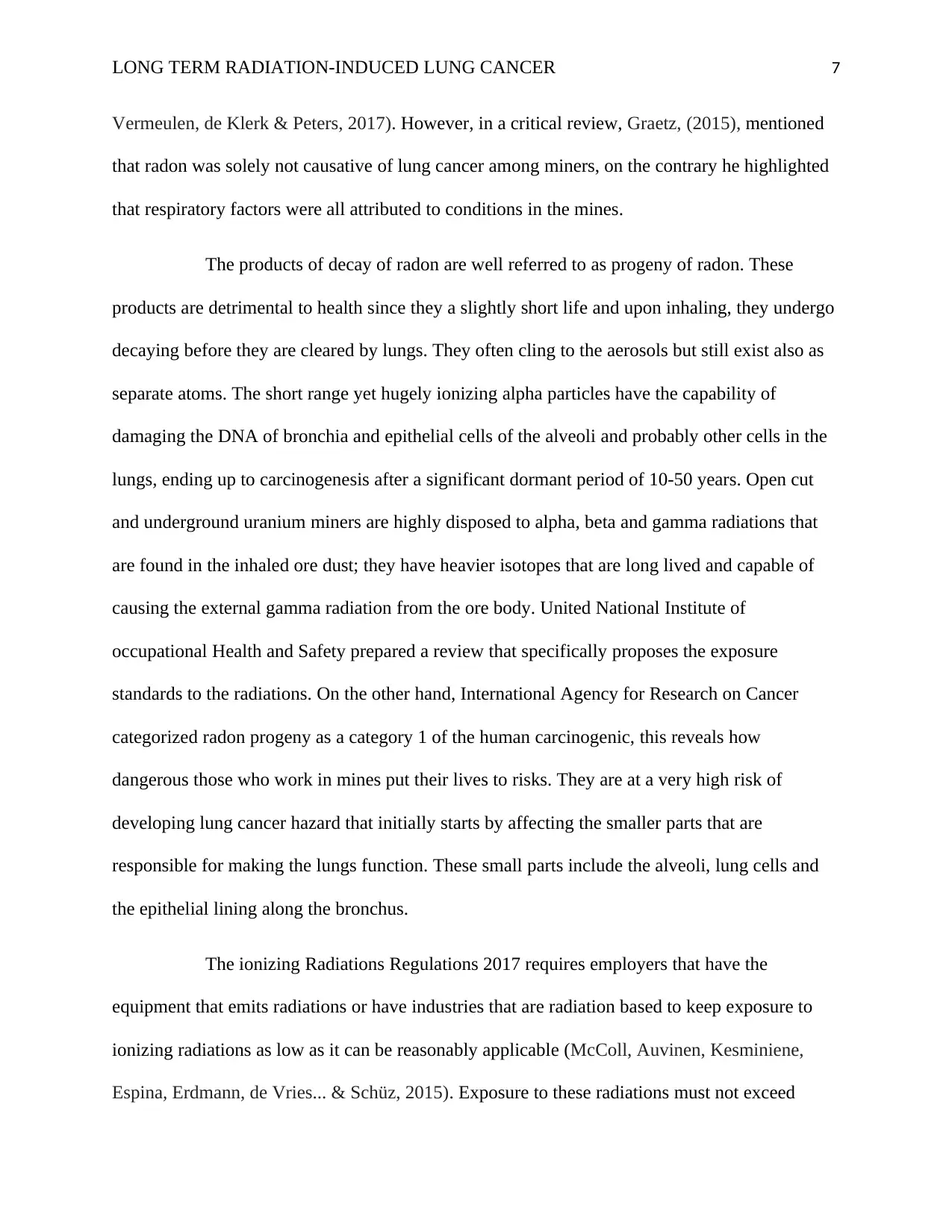
LONG TERM RADIATION-INDUCED LUNG CANCER 7
Vermeulen, de Klerk & Peters, 2017). However, in a critical review, Graetz, (2015), mentioned
that radon was solely not causative of lung cancer among miners, on the contrary he highlighted
that respiratory factors were all attributed to conditions in the mines.
The products of decay of radon are well referred to as progeny of radon. These
products are detrimental to health since they a slightly short life and upon inhaling, they undergo
decaying before they are cleared by lungs. They often cling to the aerosols but still exist also as
separate atoms. The short range yet hugely ionizing alpha particles have the capability of
damaging the DNA of bronchia and epithelial cells of the alveoli and probably other cells in the
lungs, ending up to carcinogenesis after a significant dormant period of 10-50 years. Open cut
and underground uranium miners are highly disposed to alpha, beta and gamma radiations that
are found in the inhaled ore dust; they have heavier isotopes that are long lived and capable of
causing the external gamma radiation from the ore body. United National Institute of
occupational Health and Safety prepared a review that specifically proposes the exposure
standards to the radiations. On the other hand, International Agency for Research on Cancer
categorized radon progeny as a category 1 of the human carcinogenic, this reveals how
dangerous those who work in mines put their lives to risks. They are at a very high risk of
developing lung cancer hazard that initially starts by affecting the smaller parts that are
responsible for making the lungs function. These small parts include the alveoli, lung cells and
the epithelial lining along the bronchus.
The ionizing Radiations Regulations 2017 requires employers that have the
equipment that emits radiations or have industries that are radiation based to keep exposure to
ionizing radiations as low as it can be reasonably applicable (McColl, Auvinen, Kesminiene,
Espina, Erdmann, de Vries... & Schüz, 2015). Exposure to these radiations must not exceed
Vermeulen, de Klerk & Peters, 2017). However, in a critical review, Graetz, (2015), mentioned
that radon was solely not causative of lung cancer among miners, on the contrary he highlighted
that respiratory factors were all attributed to conditions in the mines.
The products of decay of radon are well referred to as progeny of radon. These
products are detrimental to health since they a slightly short life and upon inhaling, they undergo
decaying before they are cleared by lungs. They often cling to the aerosols but still exist also as
separate atoms. The short range yet hugely ionizing alpha particles have the capability of
damaging the DNA of bronchia and epithelial cells of the alveoli and probably other cells in the
lungs, ending up to carcinogenesis after a significant dormant period of 10-50 years. Open cut
and underground uranium miners are highly disposed to alpha, beta and gamma radiations that
are found in the inhaled ore dust; they have heavier isotopes that are long lived and capable of
causing the external gamma radiation from the ore body. United National Institute of
occupational Health and Safety prepared a review that specifically proposes the exposure
standards to the radiations. On the other hand, International Agency for Research on Cancer
categorized radon progeny as a category 1 of the human carcinogenic, this reveals how
dangerous those who work in mines put their lives to risks. They are at a very high risk of
developing lung cancer hazard that initially starts by affecting the smaller parts that are
responsible for making the lungs function. These small parts include the alveoli, lung cells and
the epithelial lining along the bronchus.
The ionizing Radiations Regulations 2017 requires employers that have the
equipment that emits radiations or have industries that are radiation based to keep exposure to
ionizing radiations as low as it can be reasonably applicable (McColl, Auvinen, Kesminiene,
Espina, Erdmann, de Vries... & Schüz, 2015). Exposure to these radiations must not exceed
Paraphrase This Document
Need a fresh take? Get an instant paraphrase of this document with our AI Paraphraser
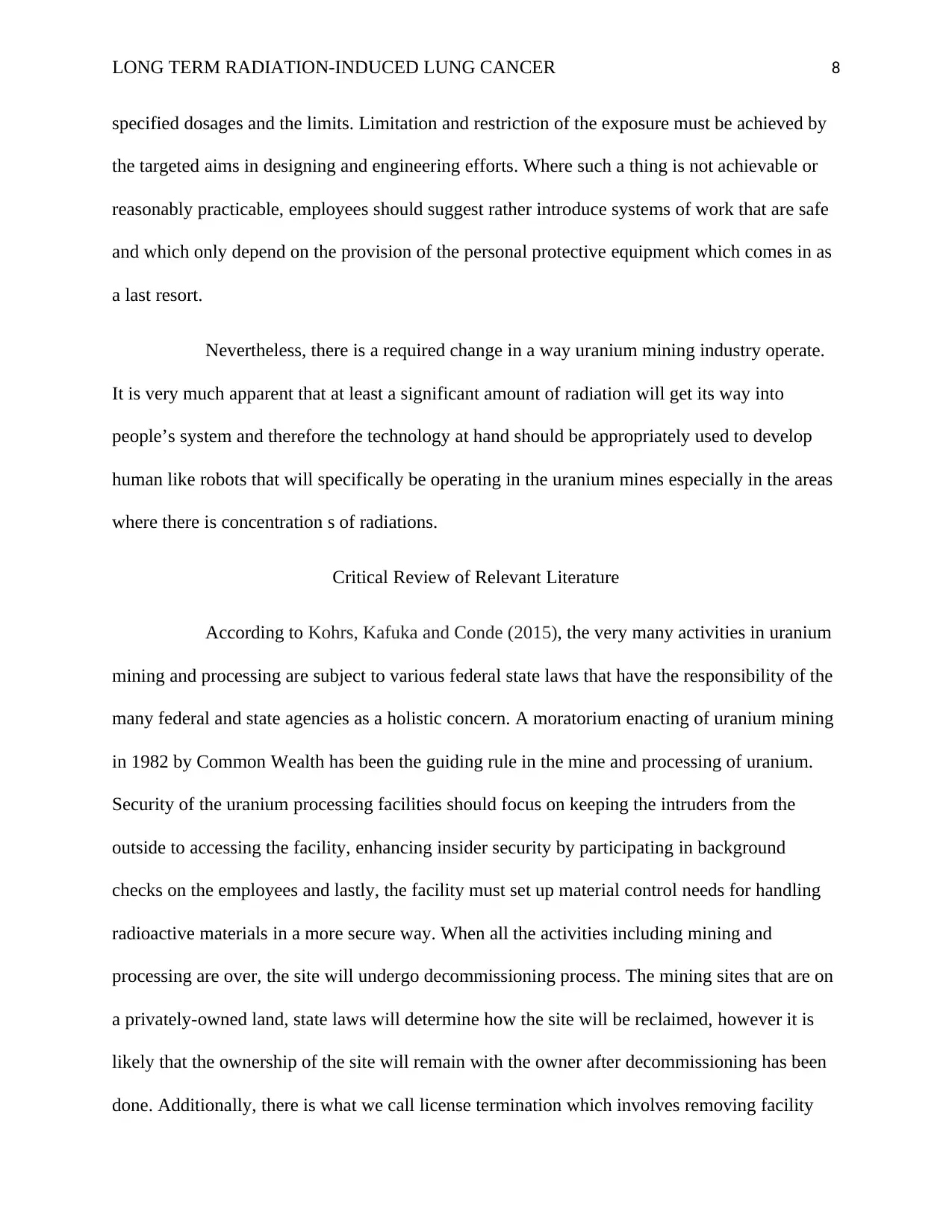
LONG TERM RADIATION-INDUCED LUNG CANCER 8
specified dosages and the limits. Limitation and restriction of the exposure must be achieved by
the targeted aims in designing and engineering efforts. Where such a thing is not achievable or
reasonably practicable, employees should suggest rather introduce systems of work that are safe
and which only depend on the provision of the personal protective equipment which comes in as
a last resort.
Nevertheless, there is a required change in a way uranium mining industry operate.
It is very much apparent that at least a significant amount of radiation will get its way into
people’s system and therefore the technology at hand should be appropriately used to develop
human like robots that will specifically be operating in the uranium mines especially in the areas
where there is concentration s of radiations.
Critical Review of Relevant Literature
According to Kohrs, Kafuka and Conde (2015), the very many activities in uranium
mining and processing are subject to various federal state laws that have the responsibility of the
many federal and state agencies as a holistic concern. A moratorium enacting of uranium mining
in 1982 by Common Wealth has been the guiding rule in the mine and processing of uranium.
Security of the uranium processing facilities should focus on keeping the intruders from the
outside to accessing the facility, enhancing insider security by participating in background
checks on the employees and lastly, the facility must set up material control needs for handling
radioactive materials in a more secure way. When all the activities including mining and
processing are over, the site will undergo decommissioning process. The mining sites that are on
a privately-owned land, state laws will determine how the site will be reclaimed, however it is
likely that the ownership of the site will remain with the owner after decommissioning has been
done. Additionally, there is what we call license termination which involves removing facility
specified dosages and the limits. Limitation and restriction of the exposure must be achieved by
the targeted aims in designing and engineering efforts. Where such a thing is not achievable or
reasonably practicable, employees should suggest rather introduce systems of work that are safe
and which only depend on the provision of the personal protective equipment which comes in as
a last resort.
Nevertheless, there is a required change in a way uranium mining industry operate.
It is very much apparent that at least a significant amount of radiation will get its way into
people’s system and therefore the technology at hand should be appropriately used to develop
human like robots that will specifically be operating in the uranium mines especially in the areas
where there is concentration s of radiations.
Critical Review of Relevant Literature
According to Kohrs, Kafuka and Conde (2015), the very many activities in uranium
mining and processing are subject to various federal state laws that have the responsibility of the
many federal and state agencies as a holistic concern. A moratorium enacting of uranium mining
in 1982 by Common Wealth has been the guiding rule in the mine and processing of uranium.
Security of the uranium processing facilities should focus on keeping the intruders from the
outside to accessing the facility, enhancing insider security by participating in background
checks on the employees and lastly, the facility must set up material control needs for handling
radioactive materials in a more secure way. When all the activities including mining and
processing are over, the site will undergo decommissioning process. The mining sites that are on
a privately-owned land, state laws will determine how the site will be reclaimed, however it is
likely that the ownership of the site will remain with the owner after decommissioning has been
done. Additionally, there is what we call license termination which involves removing facility
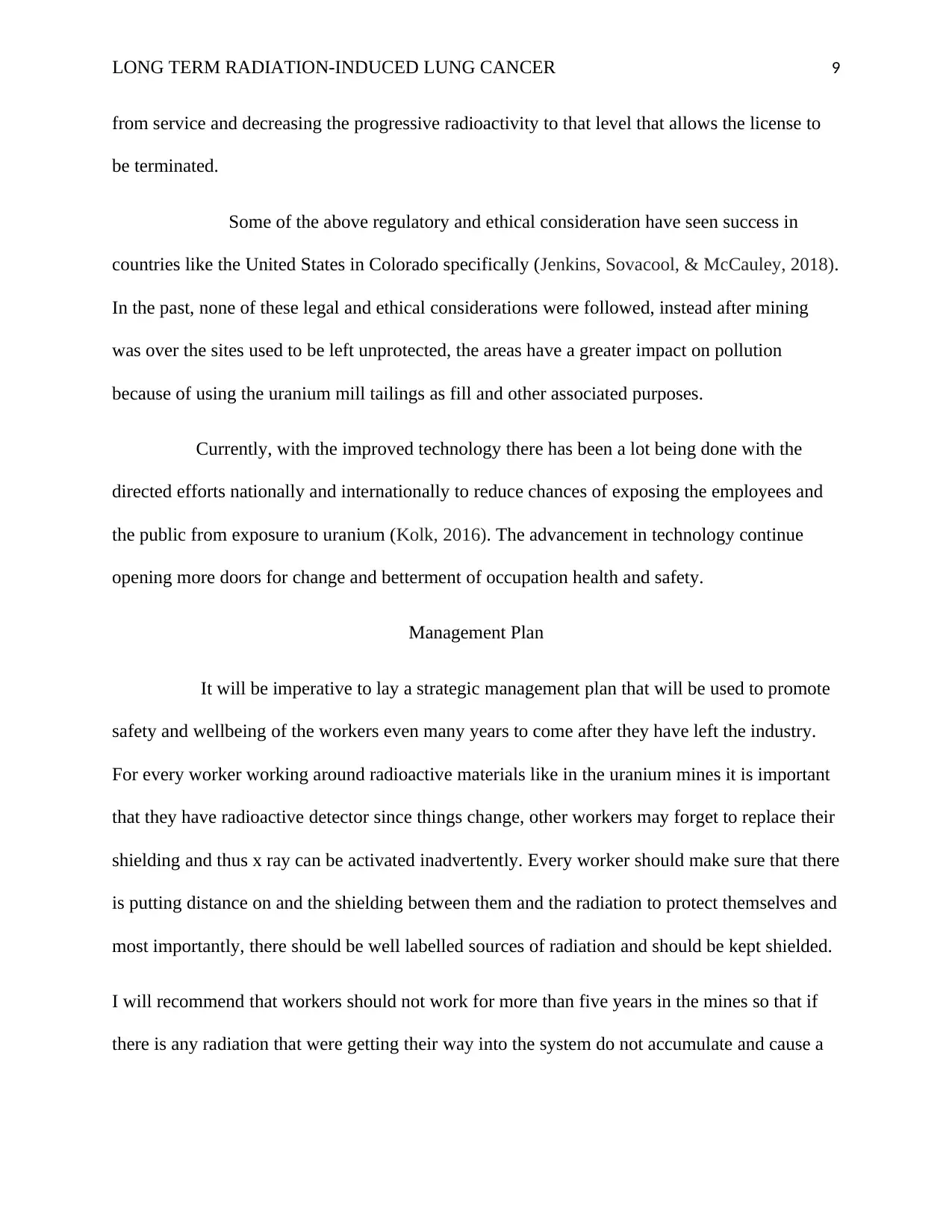
LONG TERM RADIATION-INDUCED LUNG CANCER 9
from service and decreasing the progressive radioactivity to that level that allows the license to
be terminated.
Some of the above regulatory and ethical consideration have seen success in
countries like the United States in Colorado specifically (Jenkins, Sovacool, & McCauley, 2018).
In the past, none of these legal and ethical considerations were followed, instead after mining
was over the sites used to be left unprotected, the areas have a greater impact on pollution
because of using the uranium mill tailings as fill and other associated purposes.
Currently, with the improved technology there has been a lot being done with the
directed efforts nationally and internationally to reduce chances of exposing the employees and
the public from exposure to uranium (Kolk, 2016). The advancement in technology continue
opening more doors for change and betterment of occupation health and safety.
Management Plan
It will be imperative to lay a strategic management plan that will be used to promote
safety and wellbeing of the workers even many years to come after they have left the industry.
For every worker working around radioactive materials like in the uranium mines it is important
that they have radioactive detector since things change, other workers may forget to replace their
shielding and thus x ray can be activated inadvertently. Every worker should make sure that there
is putting distance on and the shielding between them and the radiation to protect themselves and
most importantly, there should be well labelled sources of radiation and should be kept shielded.
I will recommend that workers should not work for more than five years in the mines so that if
there is any radiation that were getting their way into the system do not accumulate and cause a
from service and decreasing the progressive radioactivity to that level that allows the license to
be terminated.
Some of the above regulatory and ethical consideration have seen success in
countries like the United States in Colorado specifically (Jenkins, Sovacool, & McCauley, 2018).
In the past, none of these legal and ethical considerations were followed, instead after mining
was over the sites used to be left unprotected, the areas have a greater impact on pollution
because of using the uranium mill tailings as fill and other associated purposes.
Currently, with the improved technology there has been a lot being done with the
directed efforts nationally and internationally to reduce chances of exposing the employees and
the public from exposure to uranium (Kolk, 2016). The advancement in technology continue
opening more doors for change and betterment of occupation health and safety.
Management Plan
It will be imperative to lay a strategic management plan that will be used to promote
safety and wellbeing of the workers even many years to come after they have left the industry.
For every worker working around radioactive materials like in the uranium mines it is important
that they have radioactive detector since things change, other workers may forget to replace their
shielding and thus x ray can be activated inadvertently. Every worker should make sure that there
is putting distance on and the shielding between them and the radiation to protect themselves and
most importantly, there should be well labelled sources of radiation and should be kept shielded.
I will recommend that workers should not work for more than five years in the mines so that if
there is any radiation that were getting their way into the system do not accumulate and cause a
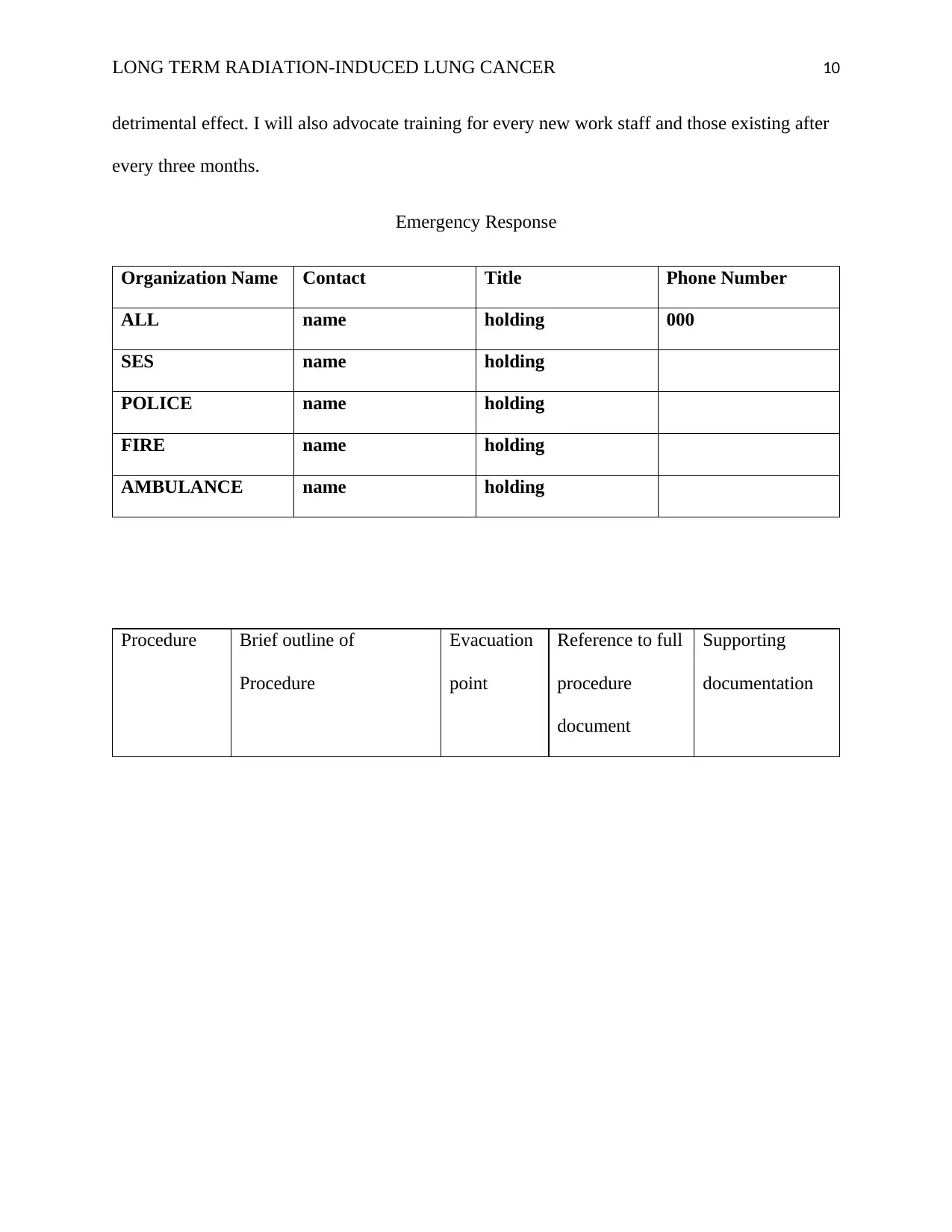
LONG TERM RADIATION-INDUCED LUNG CANCER 10
detrimental effect. I will also advocate training for every new work staff and those existing after
every three months.
Emergency Response
Organization Name Contact Title Phone Number
ALL name holding 000
SES name holding
POLICE name holding
FIRE name holding
AMBULANCE name holding
Procedure Brief outline of
Procedure
Evacuation
point
Reference to full
procedure
document
Supporting
documentation
detrimental effect. I will also advocate training for every new work staff and those existing after
every three months.
Emergency Response
Organization Name Contact Title Phone Number
ALL name holding 000
SES name holding
POLICE name holding
FIRE name holding
AMBULANCE name holding
Procedure Brief outline of
Procedure
Evacuation
point
Reference to full
procedure
document
Supporting
documentation
Secure Best Marks with AI Grader
Need help grading? Try our AI Grader for instant feedback on your assignments.
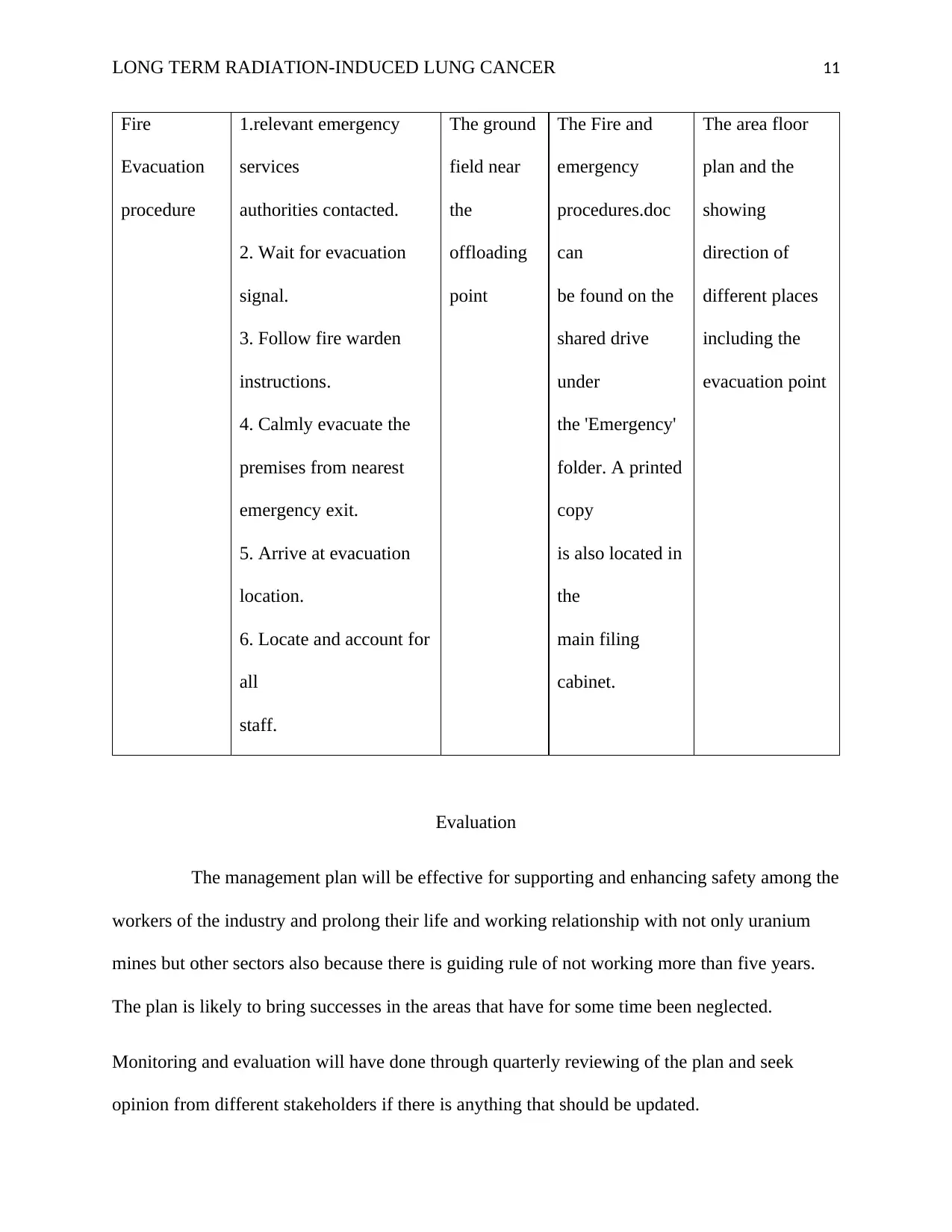
LONG TERM RADIATION-INDUCED LUNG CANCER 11
Fire
Evacuation
procedure
1.relevant emergency
services
authorities contacted.
2. Wait for evacuation
signal.
3. Follow fire warden
instructions.
4. Calmly evacuate the
premises from nearest
emergency exit.
5. Arrive at evacuation
location.
6. Locate and account for
all
staff.
The ground
field near
the
offloading
point
The Fire and
emergency
procedures.doc
can
be found on the
shared drive
under
the 'Emergency'
folder. A printed
copy
is also located in
the
main filing
cabinet.
The area floor
plan and the
showing
direction of
different places
including the
evacuation point
Evaluation
The management plan will be effective for supporting and enhancing safety among the
workers of the industry and prolong their life and working relationship with not only uranium
mines but other sectors also because there is guiding rule of not working more than five years.
The plan is likely to bring successes in the areas that have for some time been neglected.
Monitoring and evaluation will have done through quarterly reviewing of the plan and seek
opinion from different stakeholders if there is anything that should be updated.
Fire
Evacuation
procedure
1.relevant emergency
services
authorities contacted.
2. Wait for evacuation
signal.
3. Follow fire warden
instructions.
4. Calmly evacuate the
premises from nearest
emergency exit.
5. Arrive at evacuation
location.
6. Locate and account for
all
staff.
The ground
field near
the
offloading
point
The Fire and
emergency
procedures.doc
can
be found on the
shared drive
under
the 'Emergency'
folder. A printed
copy
is also located in
the
main filing
cabinet.
The area floor
plan and the
showing
direction of
different places
including the
evacuation point
Evaluation
The management plan will be effective for supporting and enhancing safety among the
workers of the industry and prolong their life and working relationship with not only uranium
mines but other sectors also because there is guiding rule of not working more than five years.
The plan is likely to bring successes in the areas that have for some time been neglected.
Monitoring and evaluation will have done through quarterly reviewing of the plan and seek
opinion from different stakeholders if there is anything that should be updated.
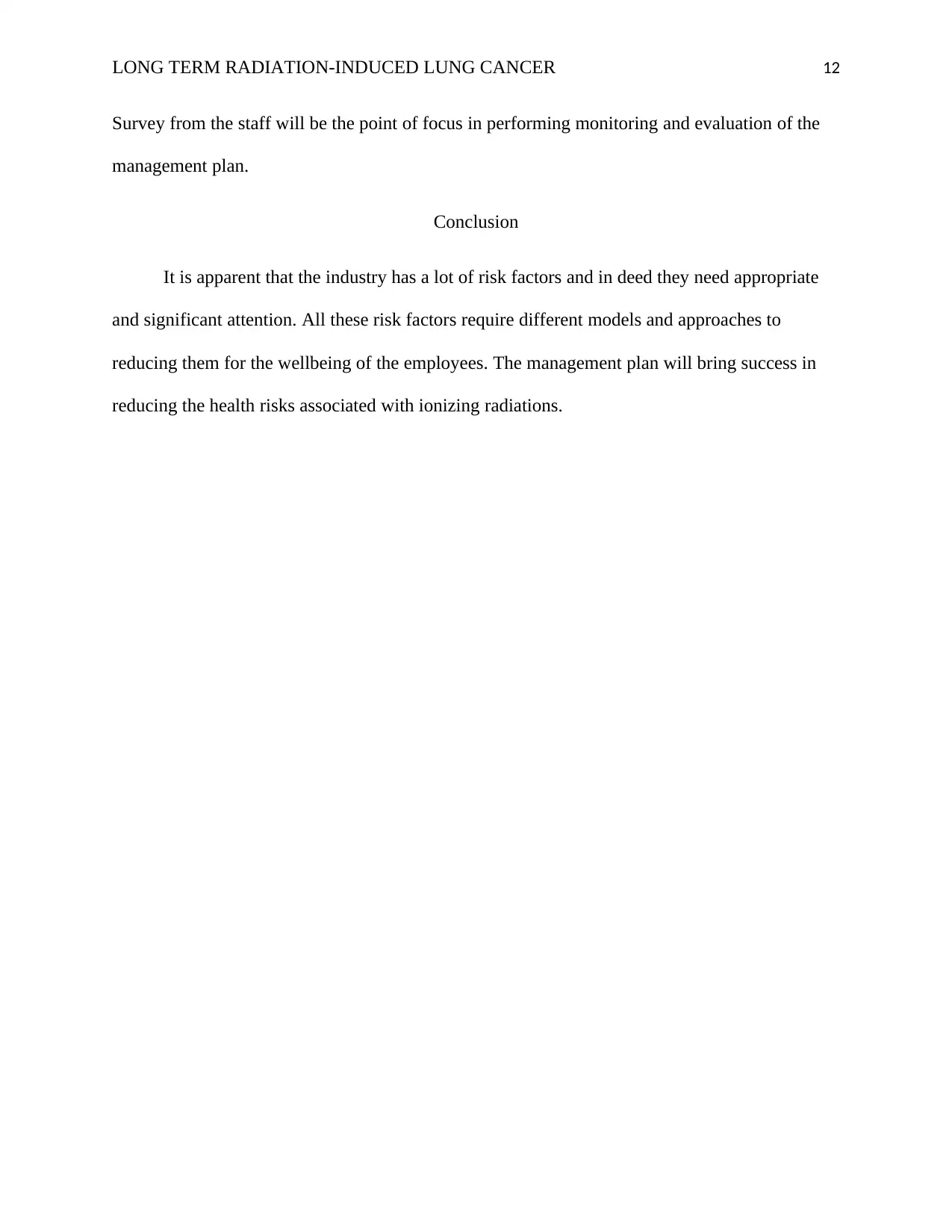
LONG TERM RADIATION-INDUCED LUNG CANCER 12
Survey from the staff will be the point of focus in performing monitoring and evaluation of the
management plan.
Conclusion
It is apparent that the industry has a lot of risk factors and in deed they need appropriate
and significant attention. All these risk factors require different models and approaches to
reducing them for the wellbeing of the employees. The management plan will bring success in
reducing the health risks associated with ionizing radiations.
Survey from the staff will be the point of focus in performing monitoring and evaluation of the
management plan.
Conclusion
It is apparent that the industry has a lot of risk factors and in deed they need appropriate
and significant attention. All these risk factors require different models and approaches to
reducing them for the wellbeing of the employees. The management plan will bring success in
reducing the health risks associated with ionizing radiations.
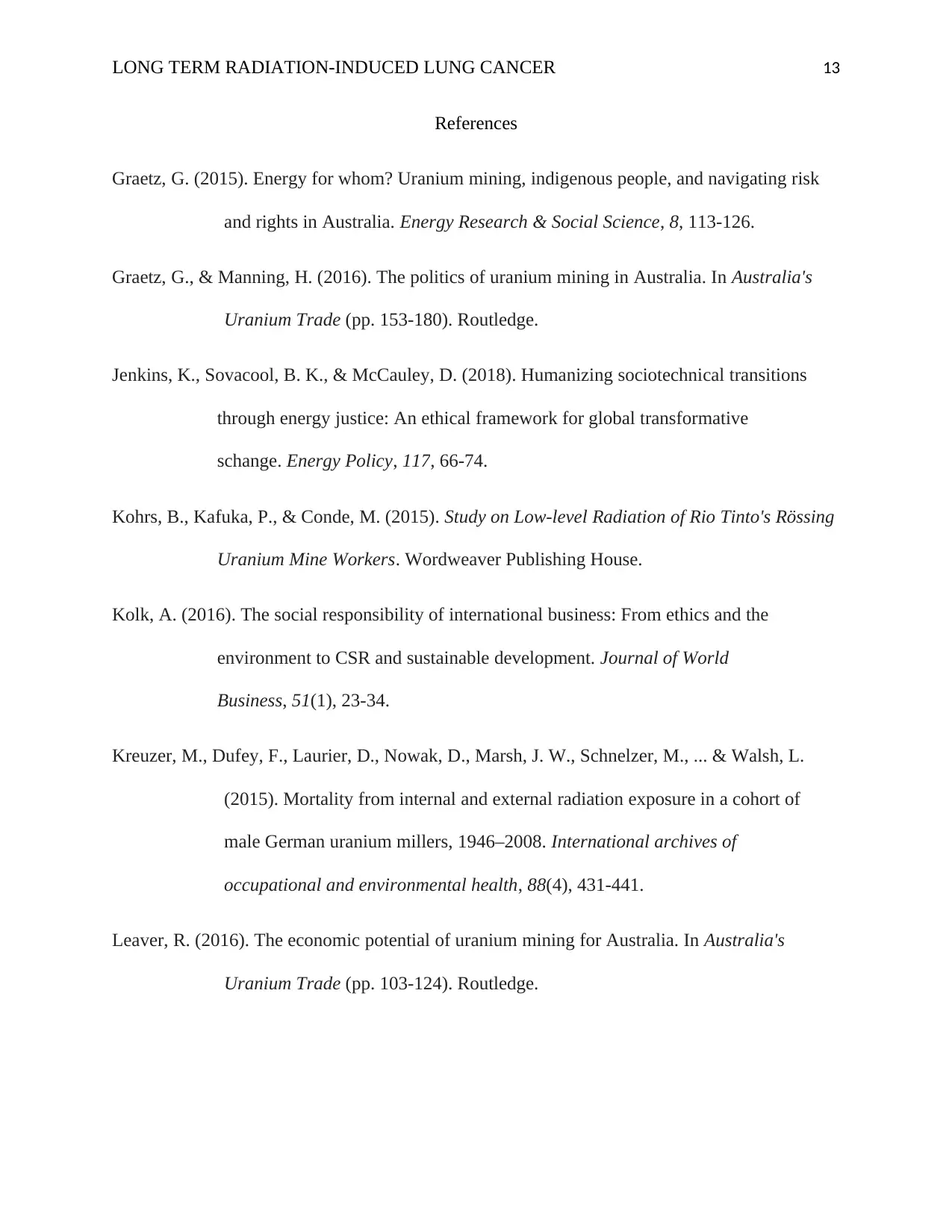
LONG TERM RADIATION-INDUCED LUNG CANCER 13
References
Graetz, G. (2015). Energy for whom? Uranium mining, indigenous people, and navigating risk
and rights in Australia. Energy Research & Social Science, 8, 113-126.
Graetz, G., & Manning, H. (2016). The politics of uranium mining in Australia. In Australia's
Uranium Trade (pp. 153-180). Routledge.
Jenkins, K., Sovacool, B. K., & McCauley, D. (2018). Humanizing sociotechnical transitions
through energy justice: An ethical framework for global transformative
schange. Energy Policy, 117, 66-74.
Kohrs, B., Kafuka, P., & Conde, M. (2015). Study on Low-level Radiation of Rio Tinto's Rössing
Uranium Mine Workers. Wordweaver Publishing House.
Kolk, A. (2016). The social responsibility of international business: From ethics and the
environment to CSR and sustainable development. Journal of World
Business, 51(1), 23-34.
Kreuzer, M., Dufey, F., Laurier, D., Nowak, D., Marsh, J. W., Schnelzer, M., ... & Walsh, L.
(2015). Mortality from internal and external radiation exposure in a cohort of
male German uranium millers, 1946–2008. International archives of
occupational and environmental health, 88(4), 431-441.
Leaver, R. (2016). The economic potential of uranium mining for Australia. In Australia's
Uranium Trade (pp. 103-124). Routledge.
References
Graetz, G. (2015). Energy for whom? Uranium mining, indigenous people, and navigating risk
and rights in Australia. Energy Research & Social Science, 8, 113-126.
Graetz, G., & Manning, H. (2016). The politics of uranium mining in Australia. In Australia's
Uranium Trade (pp. 153-180). Routledge.
Jenkins, K., Sovacool, B. K., & McCauley, D. (2018). Humanizing sociotechnical transitions
through energy justice: An ethical framework for global transformative
schange. Energy Policy, 117, 66-74.
Kohrs, B., Kafuka, P., & Conde, M. (2015). Study on Low-level Radiation of Rio Tinto's Rössing
Uranium Mine Workers. Wordweaver Publishing House.
Kolk, A. (2016). The social responsibility of international business: From ethics and the
environment to CSR and sustainable development. Journal of World
Business, 51(1), 23-34.
Kreuzer, M., Dufey, F., Laurier, D., Nowak, D., Marsh, J. W., Schnelzer, M., ... & Walsh, L.
(2015). Mortality from internal and external radiation exposure in a cohort of
male German uranium millers, 1946–2008. International archives of
occupational and environmental health, 88(4), 431-441.
Leaver, R. (2016). The economic potential of uranium mining for Australia. In Australia's
Uranium Trade (pp. 103-124). Routledge.
Paraphrase This Document
Need a fresh take? Get an instant paraphrase of this document with our AI Paraphraser
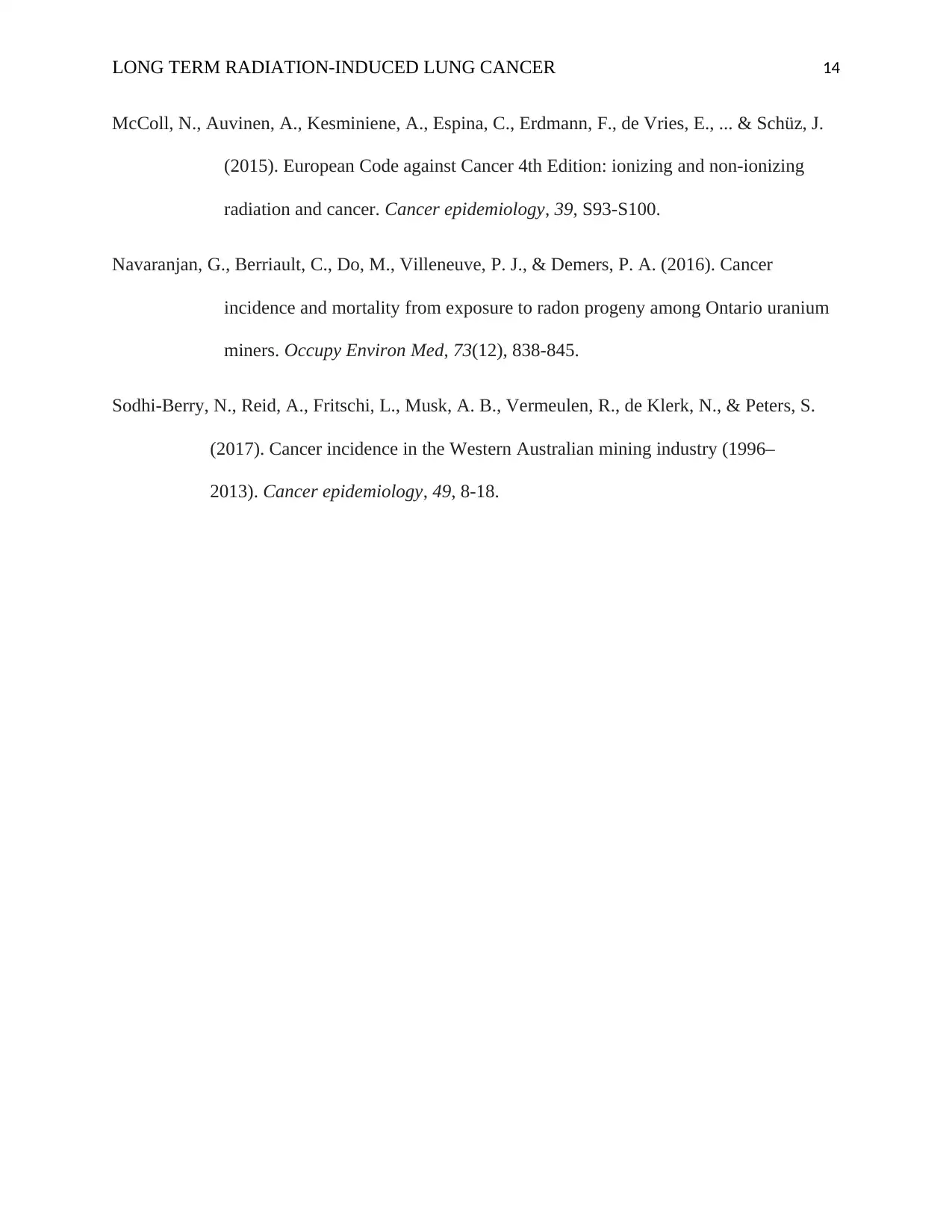
LONG TERM RADIATION-INDUCED LUNG CANCER 14
McColl, N., Auvinen, A., Kesminiene, A., Espina, C., Erdmann, F., de Vries, E., ... & Schüz, J.
(2015). European Code against Cancer 4th Edition: ionizing and non-ionizing
radiation and cancer. Cancer epidemiology, 39, S93-S100.
Navaranjan, G., Berriault, C., Do, M., Villeneuve, P. J., & Demers, P. A. (2016). Cancer
incidence and mortality from exposure to radon progeny among Ontario uranium
miners. Occupy Environ Med, 73(12), 838-845.
Sodhi-Berry, N., Reid, A., Fritschi, L., Musk, A. B., Vermeulen, R., de Klerk, N., & Peters, S.
(2017). Cancer incidence in the Western Australian mining industry (1996–
2013). Cancer epidemiology, 49, 8-18.
McColl, N., Auvinen, A., Kesminiene, A., Espina, C., Erdmann, F., de Vries, E., ... & Schüz, J.
(2015). European Code against Cancer 4th Edition: ionizing and non-ionizing
radiation and cancer. Cancer epidemiology, 39, S93-S100.
Navaranjan, G., Berriault, C., Do, M., Villeneuve, P. J., & Demers, P. A. (2016). Cancer
incidence and mortality from exposure to radon progeny among Ontario uranium
miners. Occupy Environ Med, 73(12), 838-845.
Sodhi-Berry, N., Reid, A., Fritschi, L., Musk, A. B., Vermeulen, R., de Klerk, N., & Peters, S.
(2017). Cancer incidence in the Western Australian mining industry (1996–
2013). Cancer epidemiology, 49, 8-18.
1 out of 14
Related Documents
Your All-in-One AI-Powered Toolkit for Academic Success.
+13062052269
info@desklib.com
Available 24*7 on WhatsApp / Email
![[object Object]](/_next/static/media/star-bottom.7253800d.svg)
Unlock your academic potential
© 2024 | Zucol Services PVT LTD | All rights reserved.





